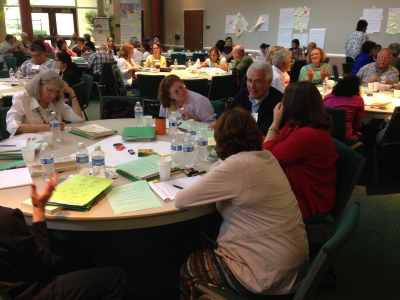 My first experience of teaching adults was a lector training I did in the first parish I worked in. I was soooo nervous. I typed out my presentation (on a manual typewriter, pre-PowerPoint days), which came out to be 13 double-spaced pages. Then I stood in front of those suffering souls and read all 13 pages to them. It was dreadful. But I learned from my mistake, and I was better the next time. And I was even better the time after that. And eventually, I became a pretty good lector trainer.
My first experience of teaching adults was a lector training I did in the first parish I worked in. I was soooo nervous. I typed out my presentation (on a manual typewriter, pre-PowerPoint days), which came out to be 13 double-spaced pages. Then I stood in front of those suffering souls and read all 13 pages to them. It was dreadful. But I learned from my mistake, and I was better the next time. And I was even better the time after that. And eventually, I became a pretty good lector trainer.
Death by PowerPoint
Years later, I had a more formal teaching experience. I was asked to teach a liturgy course in our diocesan ministry training program. This time, I was armed with PowerPoint. I had fading slides, and spinning graphics, and text that bounced in from the top of the screen. Again, dreadful. And again, I learned. I got better. I still teach that course, and it is one of the highest rated courses in the program by the students.
Want to know the secret of how I became a great teacher? The secret is that I always ask if I would have enjoyed the training if I weren’t the one leading it. I think hard about what kind of training I would want to participate in. I know I get bored when a speaker reads a prepared text to me. I hate it when a presenter uses a glitzy PowerPoint. And I am frustrated when I don’t get to share my thoughts or voice my opinion in a session.
Unlock your secret potential as an RCIA leader
When it comes to being a successful RCIA catechist, the secret is to ask yourself what gets you excited about being Catholic. I’m going to bet that listening to lectures about doctrine is not what gets your spiritual engine revved up. As RCIA leaders, we have to ask if what we are doing in the RCIA would excite us about being Catholic. Sometimes, it’s a stretch. The things that excite me about being Catholic are not always the things that are going on in the catechumenate training sessions.
For example, one thing I love about being Catholic is our symbolic imagination. We have a treasure trove of symbols, filled with deep theological meaning. But I don’t say that to the catechumens. I don’t tell them what the symbols are, and I don’t give them a lecture on the theology of the symbols.
I take them over the to church. I ask them to spend a few moments in prayer, asking the Holy Spirit to guide them. Then, when they are ready, they are to go stand next to something in the church they feel drawn to or something that intrigues them. If someone stands next to the font, I ask her to tell us why that intrigues her. I keep asking questions, asking her to go deeper, to say more, to stretch her imagination. Very often, the catechumen will already have within her the seeds of a rich theology of baptism. I may have to fill in few blanks, but drawing the bulk of the teaching out of her instead of me first telling her what she should believe is a powerful learning experience.
So here is an exercise to help you unlock your own secret to becoming a great teacher. List the top ten things you love about being Catholic. And then teach the catechumens how to participate in those ten things. Don’t read to them about the ten things or show them a PowerPoint about the ten things. Take them out into the parish and get them to do the things that you love.
Kick-start our imaginations
What do you love about being Catholic? And how can you help the catechumens learn about those things? You can help the rest of us get started on this. In the comments box, list a couple of things from your top-ten list and share a little about how you might teach the catechumens to do those things.








